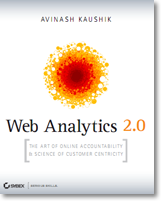Across every layer of the company, business people get too much data. Hunting expeditions are launched to locate what’s relevant and useful.
CMO scorecards have impressions! Agencies are using CPMs, or worse “Traffic” as primary KPI. A Bank’s CMO has NPS on their dashboard – NPS is sourced from everything a company does AFTER Marketing’s done!
I now spend most of my time practicing the art of strategy — how to have an outsized impact across the entire business (with an eye to moving Profits). My approach to rolling back the complexity in data pukes, sorry, dashboards, is simple:
Separate out the Critically Crucial from Diagnostically Helpful from Minor Bits.
AKA Separate the KPIs from Metrics, and both of those from Influencing Variables.
That separation dramatically reduces confusion. It sharpens the focus of the Extremely Senior Leaders (ESLs) on what actually matters. It serves notice to the Agencies and Platforms that in-flight optimization is of vital tactical importance, and it is one thing 100% in their control. Win. Win. Win.
This allows you to win before you spend, win while you spend, and win the future!
As simple as this sounds, so many teams and Agencies find this challenging. To help my clients, I’ve gone and identified what differentiates KPIs, Metrics, IVs across 11 variables.
Let me share that with you today.
Big 3 Definitions.
A Key Performance Indicator (KPI), is a metric whose movement directly impacts the company’s bottom line.
Not through two or seven connecting steps, directly. Hence, they are typically used to measure a company’s topline objectives.
Incremental Revenue, Unaided Brand Awareness are examples of KPIs.
A Metric is a number that is used to track performance.
Some metrics are directly connected to the company’s bottom line, they are called, KPIs. 😊 More commonly, they are used to diagnose the why when KPIs go up and down. Hence, I use the terms KPIs and Diagnostic Metrics.
Cart Abandonment Rate, Audio Video On Complete (AVOC) are examples of Metrics.
An Influencing Variable (IV) is a number that most often explains the performance of a Metric.
More specifically, an IV explains a part of what’s going on with a Metric (up/down/around).
Bids, On-Target % are examples of Influencing Variables.
Important: Performance of one KPI will be explained by multiple Metrics. The performance of one Metric will be explained by multiple Influencing Variables.

In this example, 1 KPI is explained by four Diagnostic Metrics, and the first Diagnostic Metric is explained by six Influencing Variables!
This is not unusual. For any KPI that is directly connected to the company's bottom line, you'll have four to six Diagnostic Metrics, and a total of 25 to 35 Influencing Variables. #OMG
That should explain why our Reports and Dashboards are such massive data pukes. It also explains why it is essential to identify these three clearly so you can simplify complexity. Finally, now you know why I insist in my Strategic Consulting practice: Please, please, no more than four KPIs for the entire business!
[Note: TMAI Premium Members: Please review the detailed, with examples, three-part series: TMAI #337, 338, 339: World’s Greatest CMO Dashboard. If you can’t find it, just email me.]
KPIs, Diagnostic Metrics, Influencing Variables: Key Dimensions.
I highly recommend you grab your CxO dashboards, gather your team, and go through an exercise to separate KPIs from Metrics from IVs.
I’ll give you 1,000 bonus points if for each KPI, you identify the Diagnostic Metrics, and for them, the cluster of Influencing Variables.
To help you with this exercise, I want to share 11 dimensions that sharply explain the differences.
By the end, even if you would rather not be, you’ll be an Analysis Ninja!
1. Who Sets Them?
Your CMO (/CxO) will personally identify the KPIs. She/He will directly source from their strategy, and what the Company expects them to deliver as the incremental impact on the bottom line.
Metrics are typically identified by the Director layer in the company. There will be many Directors, each ideally solving for a crystal clear KPI (for the CMO!). Hence, the Director’s success will be ensuring each Metric delivers optimal performance.
An Agency will typically identify the Influencing Variables for each Metric they are going to help be successful. If you don’t have an Agency, it will be your internal Agencyish team.
[Note: TMAI Premium Members: I cannot stress the importance of understanding this when selecting KPIs: TMAI #400: The 4Ps of Marketing are Dead! Else, you'll pick KPIs that will lead you to career limiting moves. Email me if you can’t find #400.]
2. Purpose.
KPIs, DMs, IVs, each power different run, fix, stop decisions. Should we keep doing what we are doing (run), are there some anomalies that need addressing (fix), is the performance such we need to stop spending money (stop).
KPIs run, fix, stop high altitude items: Budgets, entire initiatives, individuals or teams.
Metrics run, fix, stop the Marketing tactics underway.
Influencing Variables run, fix, stop channel, or tactical, level execution underway for owned, earned, paid activity underway.

3. Time Orientation.
This will be super helpful in ensuring your selection is smart.
KPIs look at patterns, and influence decisions, over months, quarters, and years.
Metrics are simply not that important. They look at patterns and influence decisions weekly, and monthly.
Influencing Variables are simply not that important. They look at patterns and influence decisions daily, and weekly.
4. Measurement Focus.
Now things get really, really, interesting.
For winners who repeatedly win, KPIs use Incrementality as their core methodology.
Kissable and huggable Metrics are ones that help focus on outsmarting competition.
Yummy Influencing Variables, in 2025, are the ones that press AI execution buttons to let advanced algorithms and intelligence optimally deliver in-flight optimization. (Humans are kind of not good at this much scale.)
5. What’s Measured?
I really like this one.
KPIs: Outcomes.
Metrics: Activity.
Influencing Variables: Micro-Actions.
Simple and sexy, no?

6. Flexibility.
We underestimate this dimension. Sometimes we hold on to things well past their expiration date. Sometimes we judge too fast, and don’t go on a second date.
If your KPIs are changing all the time, something BIG is wrong. You have the wrong leader. You have no strategy. Your business is getting massively disrupted. That will be the scale of wrong.
KPIs should be questioned on an annual basis, but, if you’ve chosen them wisely, they won’t change for years.
Torture your Metrics approximately every six months. Ask this simple question: Have the actions taken based on IAbI from this Metric had a direct impact on our KPI?
[Note: Premium Members please review: TMAI #254: Rules for Revolutionaries | IABI]
At a tactical level, Marketing and Platforms/Channels have changed at a rapid pace over the last five years, and I anticipate more of the same. Hence, your Influencing Variables might become useless from one quarter to the next. Ask the same question as Metrics, and discard frequently if the answer is no.
[Bonus read: Kill Useless Web Metrics: Apply The "Three Layers Of So What" Test.]
7. Life Duration.
You can see how this flows from the above.
KPIs: Multi-year.
Metrics: Multi-quarter.
Influencing Variables: Multi-month.
A straight-forward assessment.
8. Future Visibility.
I wanted to include this, to underline that you really need to sweat the choice of your KPIs.
Only the movement in KPIs can help predict that your long-term future will be brighter or duller.
Metrics and KPIs simply don’t have predictive power.
9. Need Targets.
Absolutely mandatory for KPIs!
It is not possible to have focus, discipline, good behavior across the entire organization, without specific, measurable with high-quality methodology, Targets for your KPIs.
[Mote: TMAI Premium Subscribers refer to: TMAI #435: Methodologies Trump Metrics!]
If decent quality Analytics is being practiced in your company for two to three years, your Diagnostic Metrics will also have Targets.
If you have a super smart Agency, one clear sign of that is that they would have identified specific Influencing Variables for your Metrics, and have run/fix/stop ranges for each Influencing Variable. Those run/fix/stop levels are the Targets.
10. Explains.
KPIs explain the impact of your strategic activity on your company’s Profits.
Metrics help explain why you missed your quarterly targets.
Influencing Variables explain the success or failure of your campaign’s performance.
Easy-peasy. :)
11. Where you’ll find them most frequently?
This is the issue that started this saga for me. Dashboards filled with Influencing Variables!
Your CxO Dashboards will only contain KPIs, and for each KPI they will have IAbI. [See: The "Action Dashboard"]
Your Director, and around Director, reports will show the KPI and explain their performance by focusing on the Diagnostic Metrics.
The first picture in this newsletter illustrates just how many Influencing Variables you’ll be juggling (actually, your expensive Agency), and hence it is not surprising that you’ll find them in small font data pukes.

TMAI Premium Subscribers:
If you would like a copy of the Microsoft Excel file with the consolidated view of the 11 dimensions, and one bonus counter-intuitive life lesson, please email me and I’ll be happy to share.
Bottom line.
Building a data-influenced org is complex, and difficult. It is as much psychology, as it is analytics.
It is dang near impossible, if you don’t get the basics right.
Now go and gather your dashboards, pull your team together, and to through the exercise I’ve recommended above.
Rarely will getting the basics right be this life-altering.
Carpe diem.





 Via
Via 














Like this post? Share it:
Or you could Print or PDF it!